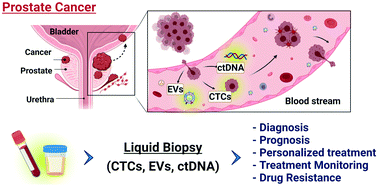The role of liquid biopsies in prostate cancer management
Abstract
Liquid biopsy has emerged as a complement to invasive tissue biopsy to guide cancer diagnosis and treatment. The common liquid biopsy biomarkers are circulating tumor cells (CTCs), extracellular vesicles (EVs), and circulating tumor DNA (ctDNA). Each biomarker provides specific information based on its intrinsic characteristics. Prostate cancer is the second most common cancer in males worldwide. In men with low-grade localized prostate cancer, the disease can often be managed by active surveillance. For men who require treatment, the 5-year survival rate of localized prostate cancer is the highest among all cancer types, but the metastatic disease remains incurable. Metastatic prostate cancer invariably progresses to involve multiple bone sites and develops into a castration-resistant disease that leads to cancer death. The need to appropriately diagnose and guide the serial treatment of men with prostate cancer has led to the implementation of many studies to apply liquid biopsies to prostate cancer management. This review describes recent advancements in isolation and detection technology and the strength and weaknesses of the three circulating biomarkers. The clinical studies based on liquid biopsy results are summarized to depict the future perspective in the role of liquid biopsy on prostate cancer management.

- This article is part of the themed collection: Microfluidics for hematology


 Please wait while we load your content...
Please wait while we load your content...
